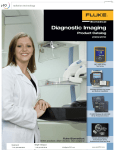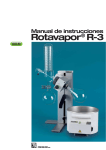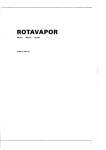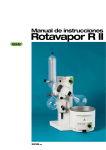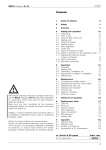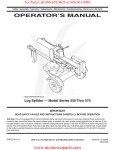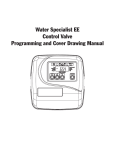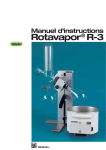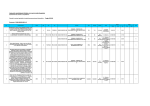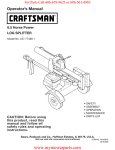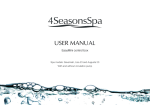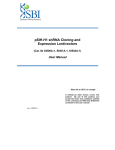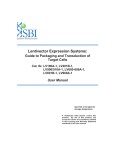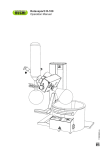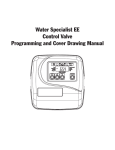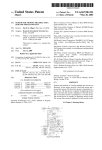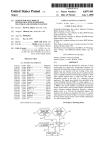Download Rotavapor® R-3
Transcript
Operation Manual ® Rotavapor R-3 093244 en Table of contents Table of contents 1 2 3 4 5 6 3 About this manual . . . . . . . . . . . . . . . . . . . . . . . . . . . . . . . . . . . Safety. . . . . . . . . . . . . . . . . . . . . . . . . . . . . . . . . . . . . . . . . . 2.1 User qualification . . . . . . . . . . . . . . . . . . . . . . . . . . . . . . . . 2.2 Proper use . . . . . . . . . . . . . . . . . . . . . . . . . . . . . . . . . . . 2.3 Improper use . . . . . . . . . . . . . . . . . . . . . . . . . . . . . . . . . . 2.4 Safety warnings and safety signals used in this manual . . . . . . . . . . . . . 2.5 Product safety. . . . . . . . . . . . . . . . . . . . . . . . . . . . . . . . . . 2.5.1 Instrument-related hazards . . . . . . . . . . . . . . . . . . . . . . . . . . . 2.5.2 Other hazards . . . . . . . . . . . . . . . . . . . . . . . . . . . . . . . . . . 2.5.3 Safety measures . . . . . . . . . . . . . . . . . . . . . . . . . . . . . . . . 2.5.4 Safety elements . . . . . . . . . . . . . . . . . . . . . . . . . . . . . . . . . 2.6 General safety rules . . . . . . . . . . . . . . . . . . . . . . . . . . . . . . . Technical data . . . . . . . . . . . . . . . . . . . . . . . . . . . . . . . . . . . . . 3.1 Scope of delivery . . . . . . . . . . . . . . . . . . . . . . . . . . . . . . . . 3.2 Technical data overview . . . . . . . . . . . . . . . . . . . . . . . . . . . . . 3.3 Materials used. . . . . . . . . . . . . . . . . . . . . . . . . . . . . . . . . . Description of function . . . . . . . . . . . . . . . . . . . . . . . . . . . . . . . . 4.1 Functional principle of a Rotavapor R-3 . . . . . . . . . . . . . . . . . . . . . 4.1.1 Front side view of the Rotavapor R-3 . . . . . . . . . . . . . . . . . . . . . . 4.1.2 Rear side view of the Rotavapor R-3 . . . . . . . . . . . . . . . . . . . . . . Installation . . . . . . . . . . . . . . . . . . . . . . . . . . . . . . . . . . . . . . . 5.1 Installation site. . . . . . . . . . . . . . . . . . . . . . . . . . . . . . . . . . 5.2 Electrical connections . . . . . . . . . . . . . . . . . . . . . . . . . . . . . . 5.3 Assembling the Rotavapor R-3 . . . . . . . . . . . . . . . . . . . . . . . . . 5.3.1 Drive unit . . . . . . . . . . . . . . . . . . . . . . . . . . . . . . . . . . . . 5.3.2 Glass parts . . . . . . . . . . . . . . . . . . . . . . . . . . . . . . . . . . . 5.3.3 Vacuum and electrical connections . . . . . . . . . . . . . . . . . . . . . . . 5.4 Heating bath medium . . . . . . . . . . . . . . . . . . . . . . . . . . . . . . 5.5 Functional test of vacuum tightness . . . . . . . . . . . . . . . . . . . . . . . Operation . . . . . . . . . . . . . . . . . . . . . . . . . . . . . . . . . . . . . . . 6.1 Switching the instrument ON and OFF and setting the heating bath temperature 6.2 Mounting the bath guide . . . . . . . . . . . . . . . . . . . . . . . . . . . . 6.3 Mounting the evaporating flask . . . . . . . . . . . . . . . . . . . . . . . . . 6.4 Lowering and raising the evaporating flask . . . . . . . . . . . . . . . . . . . 6.5 Adjusting the immersion angle of the evaporating flask into the heating bath . . 6.6 Selecting the distillation conditions . . . . . . . . . . . . . . . . . . . . . . . 6.7 Distilling . . . . . . . . . . . . . . . . . . . . . . . . . . . . . . . . . . . . . 6.8 Aspirating solvent directly into the evaporating flask . . . . . . . . . . . . . . . 6.9 Optimizing the distillation conditions . . . . . . . . . . . . . . . . . . . . . . 6.10 When the distillation is complete . . . . . . . . . . . . . . . . . . . . . . . . 6.11 Removing the evaporating flask . . . . . . . . . . . . . . . . . . . . . . . . . . . . . . . . . . . . . . . . . . . . . . . . . . . . . . . . . . . . . . . . . . . . . . . . . . . . . . . . . . . . . . . . . . . . . . . . . . . . . . . . . . . . . . . . . . . . . . . . . . . . . . . . . . . . . . . . . . . . . . . . . . . . .5 .6 .6 .6 .6 .7 .9 .9 11 11 12 12 13 13 13 14 15 15 17 18 19 19 19 20 20 21 23 24 24 25 25 26 26 27 29 30 31 32 33 34 34 R-3 Operation Manual, Version C Table of contents 7 8 9 10 11 4 Maintenance and repairs . . . . . . . . . . . 7.1 Customer service . . . . . . . . . . . . 7.2 Regular service and checks . . . . . . . 7.2.1 System tightness . . . . . . . . . . . . 7.2.2 Housing, cables and accessories . . . . 7.3 Sealing system and hoses. . . . . . . . 7.3.1 Removing the vapor duct . . . . . . . . 7.3.2 Cleaning the seals . . . . . . . . . . . . 7.3.3 Replacing the seals . . . . . . . . . . . 7.4 Heating bath . . . . . . . . . . . . . . 7.5 Glass components . . . . . . . . . . . Troubleshooting . . . . . . . . . . . . . . . . 8.1 Problem, cause and corrections . . . . . Shutdown, storage, transport and disposal . 9.1 Storage and transport . . . . . . . . . . 9.2 Disposal . . . . . . . . . . . . . . . . . 9.3 Health and safety clearance form . . . . Spare parts. . . . . . . . . . . . . . . . . . . 10.1 Glass assembly V . . . . . . . . . . . . 10.2 Glass assembly C . . . . . . . . . . . . 10.3 Sealing system . . . . . . . . . . . . . 10.4 Various glass parts . . . . . . . . . . . 10.5 Miscellaneous . . . . . . . . . . . . . . Declaration of conformity. . . . . . . . . . . . . . . . . . . . . . . . . . . . . . . . . . . . . . . . . . . . . . . . . . . . . . . . . . . . . . . . . . . . . . . . . . . . . . . . . . . . . . . . . . . . . . . . . . . . . . . . . . . . . . . . . . . . . . . . . . . . . . . . . . . . . . . . . . . . . . . . . . . . . . . . . . . . . . . . . . . . . . . . . . . . . . . . . . . . . . . . . . . . . . . . . . . . . . . . . . . . . . . . . . . . . . . . . . . . . . . . . . . . . . . . . . . . . . . . . . . . . . . . . . . . . . . . . . . . . . . . . . . . . . . . . . . . . . . . . . . . . . . . . . . . . . . . . . . . . . . . . . . . . . . . . . . . . . . . . . . . . . . . . . . . . . . . . . . . . . . . . . . . . . . . . . . . . . . . . . . . . . . . . . . . . . . . . . . . . . . . . . . . . . . . . . . . . . . . . . . . . . . . . . . . . . . . . . . . . . . . . . . . . . . . . . . . . . . . . . . . . . . . . . . . . . . . . . . . . . . . . . . . . . . . . . . . . . . . . . . . . . . . . . . . . . . . . . . . . . . . . . . . . . . . . . . . . . . . . . . . . . . . . . . . . . . . . . . . . . . . . . . . . . . . . . . . . . . . . . . 35 35 36 36 36 36 37 37 37 37 38 39 39 41 41 42 42 44 44 45 46 46 48 49 R-3 Operation Manual, Version C 1 1 About this manual About this manual This manual describes the Rotavapor R-3 and provides all information required for its safe operation and to maintain it in good working order. It is addressed to laboratory personnel and operators in particular. Read this manual carefully before installing and running your system and note the safety precautions in chapter 2 in particular. Store the manual in the immediate vicinity of the instrument, so that it can be consulted at any time. No technical modifications may be made to the instrument without the prior written agreement of Buchi. Unauthorized modifications may affect the system safety or result in accidents. Technical data are subject to change without notice. NOTE The symbols pertaining to safety (WARNINGS and ATTENTIONS) are explained in chapter 2. This manual is copyright. Information from it may not be reproduced, distributed or used for competitive purposes, nor made available to third parties. The manufacture of any component with the aid of this manual without prior written agreement is also prohibited. The English manual is the original language version and serves as basis for all translations into other languages. If you need another language version of this manual, you can download available versions at www.buchi.com. The following product names and any registered and unregistered trademarks mentioned in this manual are used for identification purposes only and remain the exclusive property of their respective owners: s Rotavapor® is a registered trademark of Büchi Labortechnik AG 5 R-3 Operation Manual, Version C 2 2 Safety Safety This chapter highlights out the safety concept of the instrument and contains general rules of behavior and warnings from direct and indirect hazards concerning the use of the product. For the users safety, all safety instructions and safety messages in the individual chapters shall be strictly observed and followed. Therefore, the manual must always be available to all persons performing the tasks described herein. 2.1 User qualification The instrument may only be used by laboratory personnel and other persons who on account of training and professional experience know of the potential dangers that can develop when operating the instrument. Untrained personnel, or persons who are currently being trained, require careful supervision by a qualified person. The present Operation Manual serves as a basis for training. 2.2 Proper use The rotary evaporator has been designed for use in technical laboratories and in production. It is authorized for use in applications that work with the evaporation and condensation of solvents. s s s s s 2.3 Evaporation of solvents and suspensions Synthesis and cleaning of refined chemicals Recycling and concentration of solvents Re-crystallization Drying of powders and granulates Improper use Applications not mentioned in section 2.2 are considered to be improper. Applications which do not comply with the technical data (see section 3 of this manual) are also considered to be improper. The operator bears the sole risk for any damages or hazards caused by improper use! The following uses are expressly forbidden: s Use of the instrument in explosive environments s Use of the instrument to process substances that are used as food, feed, cosmetic or pharmaceutical afterwards s The production and processing of materials that can cause spontaneous reactions (e.g. explosives; metal hydrids or solvents that can form peroxides) s Processing with explosive gas mixtures s Processing with oil s Working without the evaporating flask being immersed in the heating bath (risk of breakage) s The drying of hard, brittle materials (e.g., stones, soil samples) that might cause damage to the receiving flask s Sudden shock-cooling of the evaporating flask and other glass parts s Installation or use of the instrument in rooms, which require ex-protected instruments 6 R-3 Operation Manual, Version C 2 2.4 Safety Safety warnings and safety signals used in this manual DANGER, WARNING, CAUTION and NOTICE are standardized signal words for identifying levels of hazard seriousness of risks related to personal injury and property damage. All signal words, which are related to personal injury are accompanied by the general safety sign. For your safety it is important to read and fully understand the below table with the different signal words and their definitions! Sign no Signal word Definition Risk level DANGER Indicates a hazardous situation which, if not avoided, will result in death or serious injury. ★★★★ WARNING Indicates a hazardous situation which, if not avoided, could result in death or serious injury. ★★★☆ CAUTION Indicates a hazardous situation which, if not avoided, may result in minor or moderate injury. ★★☆☆ NOTICE Indicates possible property damage, but no practices related to personal injury. ★☆☆☆ (property damage only) Supplementary safety information symbols may be placed in a rectangular panel on the left to the signal word and the supplementary text (see below example). Space for supplementary safety information symbols. ! SIGNAL WORD Supplementary text, describing the kind and level of hazard / risk seriousness. s s s List of measures to avoid the herein described, hazard or hazardous situation. ... ... Table of supplementary safety information symbols The below reference list incorporates all safety information symbols used in this manual and their meaning. Symbol Meaning General warning Electrical hazard 7 R-3 Operation Manual, Version C 2 Safety Explosive gases, explosive environment Harmful to life-forms Hot item, hot surface Device damage Inhalation of substances Explosive substances Fragile items / content Heavy weight, avoid overexertion Wear protective mask Wear laboratory coat Wear protective goggles Wear protective gloves 8 R-3 Operation Manual, Version C 2 Safety Additional user information Paragraphs starting with NOTE transport helpful information for working with the device or its supplementaries. NOTEs are not related to any kind of hazard or damage (see example below). NOTE Useful tips for the easy operation of the instrument. 2.5 Product safety The Rotavapor R-3 is designed and built in accordance with current state-of-the-art technology. Nevertheless, risks to users, property, and the environment can arise when the instrument is used carelessly or improperly. The manufacturer has determined residual dangers emanating from the instrument s If the instrument is operated by insufficiently trained personnel. s If the instrument is not operated according to its proper use. Appropriate warnings in this manual serve to make the user alert to these residual dangers. 2.5.1 Instrument-related hazards Pay attention to the following safety notices: ! Danger Death or serious poisoning by inhalation of hazardous heating bath liquids. s s s s s s s ! Do not inhale fumes from the heating bath Keep the heating bath temperature on a low level Obtain the material safety data sheets of all used liquids Wear appropriate personal protective equipment Do not use liquids of unknown composition Directly withdraw released fumes and gaseous substances by sufficient ventilation Only operate the instrument in ventilated environments Warning Death or serious injuries by formation of explosive atmospheres inside the instrument. s s s s ! Directly withdraw released fumes and gaseous substances by sufficient ventilation at filling Before operation, check all gas connections for correct installation Establish inert system atmosphere before processing substances that can form explosive or reactive gases or powders Check for proper earth connection to lead off electrostatic charges Warning Death or serious injuries by use in explosive environments. s s s s 9 Do not operate the instrument in explosive environments Do not operate the instrument with explosive gas mixtures Before operation, check all gas connections for correct installation Directly withdraw released gases and gaseous substances by sufficient ventilation R-3 Operation Manual, Version C 2 ! Safety Caution Risk of minor or moderate burns when handling hot parts. s s Do not touch hot parts or surfaces Let the evaporating flask cool down for some minutes after use Notice Risk of instrument short-circuits and damage by liquids. s s s s s Do not spill liquids over the instrument or its component parts Wipe off any liquids instantly Ensure a safe positioning of the evaporating flask for storage Do not move the instrument when it is loaded with liquid Keep external vibrations away from the instrument Notice Risk of instrument damage by internal overpressure. s s Exchange clogged filters immediately Dispose of filter immediately Notice Risk of instrument damage by wrong mains supply. s s External mains supply must meet the voltage given on the type plate Check for sufficient grounding Notice Risk of glass breakage by exessive strains. s s s 10 Mount all glassware parts without strains Check glassware for proper fixing regularly and readjust fixing points if necessary Do not use defective glassware R-3 Operation Manual, Version C 2 2.5.2 Safety Other hazards The following warning sticker(s) can be found on the housing or assemblies of the Rotavapor: Symbol 2.5.3 Meaning Location Hot item, hot surface Sticker / label, located on top of the housing and at the racks Safety measures ! Warning Death or serious poisoning by contact or incorporation of harmful solvents at use. s s s s s s s s s 11 Before operation, inspect sealings and hoses for good condition Exchange worn out or defective parts immediately Before operation, check the instrument for correct assembling and proper sealing Only operate the instrument in ventilated environments Directly withdraw released gases and gaseous substances by sufficient ventilation Wear safety goggles Wear safety gloves Wear a suitable protective mask Wear a laboratory coat R-3 Operation Manual, Version C 2 2.5.4 Safety Safety elements Electronics The heating bath is equipped with a mechanical over-temperature protection. The mechanical over-temperature protection consists of a bimetal thermostat that, in case of over temperature (over 145 °C), directly interrupts the power supply. It has to be set back manually after the bath has cooled down (see also chapter 8). The electronic over-temperature protection controls the temperature limit (actual bath temperature may not exceed the given temperature by 2 °C for more than 2 minutes), the heating rate (actual temperature may not rise by more than 5 °C during 5 seconds) and the function of the temperature sensor. s The heating bath is equipped with safety fuses. s The heating bath is equipped with a thermostatic control of the bath temperature - to prevent the product from overheating Parts in direct contact with the instrument s s s s s Combi-clips for fixing the evaporating flask and for safe removal of fixed ground-glass joints. Ball joint clip for safe fixing of the receiving flask. Rods and holders for fixing the glass assemblies. Electronic over-current protection at the drive unit. Safety spring preventing the vapor duct from dropping out. Glass s Use of high quality, inert 3.3 borosilicate glass. s Use of hose connections GL-14 for preventing glass breakage. Optional s The protective shield (optional accessory) protects operators from broken glass, solvent splashes and hot heating medium in case of accidents or an implosion. s With the support rod the cold trap can additionally be clamped. 2.6 General safety rules Responsibility of the operator The head of laboratory is responsible for training his personnel. The operator shall inform the manufacturer without delay of any safety-related incidents which might occur during operation of the instrument. Legal regulations, such as local, state and federal laws applying to the instrument must be strictly followed. Duty of maintenance and care The operator is responsible for ensuring that the instrument is operated in proper condition only, and that maintenance, service, and repair jobs are performed with care and on schedule, and by authorized personnel only. Spare parts to be used Use only genuine consumables and genuine spare parts for maintenance to assure good system performance and reliability. Any modifications to the spare parts used are only allowed with the prior written permission of the manufacturer. Modifications Modifications to the instrument are only permitted after prior consultation and with the written approval of the manufacturer. Modifications and upgrades shall only be carried out by an authorized Buchi technical engineer. The manufacturer will decline any claim resulting from unauthorized modifications. 12 R-3 Operation Manual, Version C 3 3 Technical data Technical data This chapter introduces the reader to the instrument specifications. It contains the scope of delivery, technical data, requirements and performance data. 3.1 Scope of delivery Check the scope of delivery according to the order number. NOTE For detailed information on the listed products, see www.buchi.com or contact your local dealer. 3.2 Technical data overview Technical data Rotavapor R-3 Glass assemblies Dimensions (W x H x D) Weight Connection voltage V, C 430 x 535 x 315 mm 13-14 kg (depending on the glass assembly) 24 VDC Fusage Mains connection Frequency Power consumption Installation category Degree of protection Pollution degree Rotation speed range Flask size Max. flask content Temperature control range Display scale Regulation accuracy Environmental conditions Temperature Altitude via connection to heating bath R-3 or external power supply (available on request) 30 W II IP21 2 20-280 rpm 50-4000 ml 3 kg scale 0–10 R-3 Heating bath 285 x 240 x 330 mm 4 kg 100-120 V or 220-240 V ± 10% T 12.5 A L 250V (100-120 V version) / T 6.3 A L 250V (220-240 V version) 3-pole (P, N, E) via power cord 50 / 60 Hz 1700 W II IP21 2 up to 4000 ml room temperature – 95 °C Set / actual temperature ± 1 °C for indoor use only 10-40 °C up to 2000 m maximum relative humidity 80% for temperatures up to 31 °C, and then linearly Humidity decreasing to 50% at 40 °C Bath content 4l water, distilled water we recommend to add borax in a concenHeating medium tration of 0.5 g/l when using deionised water pressure increase of 10 mbar per Vacuum tightness of system 3 minutes at a pressure of < 100 mbar Temperature resistance < 160 °C protective shield 13 R-3 Operation Manual, Version C 3 3.3 Technical data Materials used Materials used Component Material designation Housing Rotavapor Aluminium (anodized) and stainless steel Housing bath and housing components PBT partially glass reinforced Bath Stainless steel Protective ring PBT partially glass reinforced Protective shield Polycarbonate Centre rotation drive Stainless steel Flange connection to cold trap Aluminum Seal NBR, PTFE 14 R-3 Operation Manual, Version C 4 4 Description of function Description of function This chapter explains the basic principle of the instrument shows how it is structured and gives a functional description of the assemblies. 4.1 Functional principle of a Rotavapor R-3 With a Rotavapor, single step distillations are performed quickly and in a product friendly manner. The basis of this procedure is the evaporation and condensation of solvents using a rotating evaporator flask under vacuum. Distilling products under vacuum increases the performance and helps to protect the products. Standard vacuum applications Due to its sophisticated sealing system a highly stable vacuum level can be reached in combination with a vacuum controller and a vacuum pump. The vacuum also eliminates unwanted or hazardous emissions of vapors during the process and serves as an important safety feature. The low pressure decreases the boiling point of the medium inside the Rotavapor. This allows to treat the product gently at even higher evaporation performance compared to environmental pressure operation. 15 R-3 Operation Manual, Version C 4 Description of function Evaporation area The solvent is heated by means of a heating bath. At liquids, the turbulent mixing inside the rotating evaporating flask results in an increased evaporation rate. The rotation also prevents a local overheating of the mixture and bumping. Rotation drive including vapor duct The drive unit ensures that the evaporating flask rotates evenly. The integrated vapor duct transports the vapor from the evaporation area to the cooling area. Cooling area The solvent vapor flows very quickly into the condenser. Here, the energy in the solvent vapor is transferred to the cooling medium (mostly water), so that the solvent condenses. Receiving flask The receiving flask collects the condensed solvent. Vacuum The vacuum reduces the boiling temperature and thus increases the distillation performance. The evaporating performance is influenced by the distillation pressure (vacuum), the heating bath temperature, and the rotation speed and size of the evaporating flask. For information on the optimum distillation conditions, see chapter Operation. NOTE For information about minimum distillation conditions see section 6, Operation. 16 R-3 Operation Manual, Version C 4 4.1.1 Description of function Front side view of the Rotavapor R-3 Condenser Stop cock for vacuum regulation Hose to continually feed the evaporating flask with solvent Lock button to block the drive unit Knob for rotation speed of evaporating flask Receiving flask for condensed solvent Quick action jack to raise and lower the evaporating flask 17 Vertical end stop Heating bath display Buttons to adjust the temperature of the heating bath Main switch Heating bath handle Stainless steel heating bath ! Evaporating flask " Combi-clip # Clamping lever for immersion angle adjustment R-3 Operation Manual, Version C 4 4.1.2 Description of function Rear side view of the Rotavapor R-3 Evaporating flask Water bath Fuse Power supply for heating bath Power supply for the drive unit of the R-3 (24 VDC) 18 Connection cable between heating bath and drive unit Replenishment hose Cooling water connection of condenser Cooling water connection of condenser Vacuum connections to condenser R-3 Operation Manual, Version C 5 5 Putting into operation Installation This chapter describes how the instrument is installed and gives instructions on initial startup. NOTE Inspect the instrument for damages during unpacking. If necessary, prepare a status report immediately to inform the postal company, railway company or transportation company. Keep the original packaging for future transportation. 5.1 Installation site Place the instrument on a stable, horizontal plane and consider the maximum product dimensions. Perform the distillations under vacuum with the Rotavapor R-3 placed inside a fume hood. If this is not possible due to shortage of space, mount the protective shield (optional accessory) and lead the exhaust gas from the pump into the fume hood. 5.2 Electrical connections The Rotavapor is aimed to be installed mobile. It is available with multiple kinds of power plugs to meet most local installation requirements. Clearance at installation site s The instrument is connected to mains via a power plug. The plug must be freely accessible at any time to be unplugged in case of emergency. Demands on the mains circuit The mains circuit must ๗ provide the voltage that is given on the type plate of the instrument. ๗ be able to handle the load of the connected instruments. ๗ be equipped with adequat fusage and electrical safety measures, in particular proper grounding. See also technical data (section 3.2) of all components regarding the different minimum system requirements! NOTE s Additional electrical safety measures such as residual current breakers may be necessary to meet local laws and regulations! s External connections and extension lines must be provided with an grounded conductor lead (3-pole couplings, cord or plug equipment). All used power cords must meet the input power requirements. Notice Risk of instrument damage by wrong mains supply. s s 19 External mains supply must meet the voltage given on the type plate Check for sufficient grounding R-3 Operation Manual, Version C 5 5.3 Assembling the Rotavapor R-3 5.3.1 Drive unit Putting into operation To complete the tower of the Rotavapor take the motor unit and unscrew the screw on the underside of the drive unit (). Loosen the clamping lever for immersion angel adjustment (). Place the drive unit on the axis of the tower (). The “angle-limiter” on the axis must be placed in the cavity of the rear cover of the drive unit. The motor must be placed within a space of approx. 4 -5 mm space between motor unit and tower (). Fix the motor with the thumb screw on the bottom side of the motor (). Make sure that the motor can not be removed from the tower. 20 R-3 Operation Manual, Version C 5 Putting into operation Finalize the mounting of the motor by tightening the clamping lever on the drive unit (). Place the Rotavapor on the laboratory table and add the heating bath in front of the tower. ! Caution Risk of minor or moderate injury by wrong assembly s s 5.3.2 Screw in the fixing thumb screw completely. Tighten the angle fixing leverage. Glass parts Mount the sealing on the flange of the condenser (). Take the vapor duct and put it trough the motor unit. This should give a click when it is mounted properly and be tight on the Rotavapor (). Place the condenser together with the seal in the flange of the drive unit (). Take care that the seal is placed around the vapor duct without damaging the PTFE part. 21 R-3 Operation Manual, Version C 5 Putting into operation Hold the condenser with your left hand until the flange is tightened to avoid that the condenser is falling down. To connect the condenser with the drive unit, fix it with the flange screw connection (). Secure the receiving flask with the clip provided for this purpose (). Put the stop cock in the condenser (). You can also secure the glass assemblies V and C using the corresponding optional support rod (rod is not included and is available as an accessory). 22 R-3 Operation Manual, Version C 5 5.3.3 Putting into operation Vacuum and electrical connections Connect the hose for providing the condenser with the cooling medium () and (). (There is no distinction between in and out of the cooling medium). For this purpose use hose connections GL-14. The used hoses must all have the same inner diameter (approximately 6 mm). For safety reasons, secure the hoses with commercial hose pivoting clamps or cable binders. Check the hoses from time to time and replace them when they are brittle. Connect an adequate vacuum source to the condenser () to apply the needed vacuum to the system. Connect the main power cable to the heating bath (). Plug the connection cable from the drive unit to the 24 VDC part on the rear side of the heating bath (). 23 R-3 Operation Manual, Version C 5 ! Putting into operation Caution Risk of minor or moderate cuts when handling damaged glass parts. s s s s 5.4 Handle glass parts with care Visually inspect every glass part before mounting Exchange damaged glass parts immediately Do not touch cracks or bits of broken glass with bare hands Heating bath medium The heating bath is suitable for the operation up to 95°C. We recommend using only water as heating bath medium. When the heating bath is used with water, please consider the following notes: Depending on the water hardness a mixture of normal water with distilled water to a ratio of 1:1 volume shares is allowed. The use of the heating bath with pure distilled or deionised water is not allowed due to the corrosiveness towards stainless steel. In case the use of pure deionised or distilled water as heating medium can not be avoided, the addition of 1 - 2 g borax (Na2B4O7 x 10 H2O) per liter water is mandatory. 5.5 Functional test of vacuum tightness Carry out the functional test after all described steps for putting the instrument into operation are finished. NOTE The functional test can only be carried out with a vacuum controller installed or when you have a pressure measuring device (manometer) connected to the hose between the vacuum source and the Rotavapor. 24 R-3 Operation Manual, Version C 6 6 Operation Operation This chapter explains the operating elements and possible operating modes. It gives instructions on how to operate the instrument properly and safely. 6.1 Switching the instrument ON and OFF and setting the heating bath temperature Switch ON/OFF the instrument with the main switch (). To adjust the water bath temperature push the button UP and DOWN on the heating bath (). During the adjustment the set temperature is displayed (). Heating activity is indicated by a dot on the display ( ). NOTE As soon as the power plug is connected and the main switch is turned on, the bath starts heating if the actual temperature is below the set temperature. For this reason, make sure that there is always water in the bath to prevent instrument damage. 25 R-3 Operation Manual, Version C 6 6.2 Operation Mounting the bath guide The bath guide serves to adjust the optimal space between the Rotavapor handle and the bath. Install the bath guide, so that the two holes on it fit in the Rotavpor base. The bath is now placed in front of the guide and the space can easily be adjusted. 6.3 Mounting the evaporating flask The evaporating flask is attached to the vapor duct (). Take care that the vapor duct is getting no damage from accidentally contacting the flask. To prefix the flask, flip the metal bracket over the flask neck (). By screwing the Combi-clip clockwise the flask is connected to the vapor duct (). ! NOTICE Risk of contamination and glass breakage. s s s s s 26 Clean and dry the exterior of the flask before installation and removal Do not drop the flask Savely support the flask at handling Savely store the flask onto a matching flask ring or holder Keep limbs out of crushing zone R-3 Operation Manual, Version C 6 6.4 Operation Lowering and raising the evaporating flask To move the drive unit with the evaporating flask, press the lift brake inside the handle (). After unlocking the drive unit you are able to move it up and down (). ! Caution Risk of minor or moderate burns when handling a hot heating bath. s Make sure that no liquid can overflow from the bath when the evaporating flask is submerged. Take care not to contact the heating bath pan while lowering the flask into the heating bath. 27 R-3 Operation Manual, Version C 6 Operation To limit the flask position to a fixed one, lower the flask as deep as necessary into the bath by means of the quick-action jack (). Then unscrew the position limitation () at the tower of the Rotavapor and place it as high as possible. ! CAUTION Risk of minor or moderate cuts when handling damaged glass parts. s s s s 28 Handle glass parts with care Visually inspect every glass part for good condition before mounting Exchange damaged glass parts immediately Do not touch cracks or bits of broken glass with bare hands R-3 Operation Manual, Version C 6 6.5 Operation Adjusting the immersion angle of the evaporating flask into the heating bath If you need to operate at a different angle, e.g. when operating with a small flask, the angle can be changed as follows. s 4URNOFFTHEINSTRUMENT s 3TABILIZETHEGLASSASSEMBLYWITHONEHANDANDLOOSENTHESCREWONTHEUNDERSIDEOFTHE drive unit. s 3ETTHECONDENSERINTHEDESIREDPOSITIONBYTILTINGTHEDRIVEUNITACCORDINGLY s 2ETIGHTENTHESCREWONTHEUNDERSIDEOFTHEDRIVEUNIT Notice Risk of glass breakage. s s 29 Do not change the immersion angle while the instrument is operating. Always support the glass assembly with one hand when loosening the anchoring. R-3 Operation Manual, Version C 6 6.6 Operation Selecting the distillation conditions To achieve optimal distillation conditions, the distillation energy supplied by the heating bath must be removed by the condenser. To ensure this, operate the instrument according to the following rule of thumb: Cooling water: max. 20 °C Vapor: 40 °C Bath: 60 ° How are these conditions achieved? s 3ETTHEBATHTEMPERATURETOª# s 3ETTHECOOLINGWATERTEMPERATURENOTHIGHERTHANª# s !LLOWCOOLINGWATERTOmOWTHROUGHTHECONDENSERATAPPROXIMATELYnLH s $ElNETHEOPERATINGVACUUMINSUCHAWAYTHATTHEBOILINGPOINTOFTHESOLVENTISª# Advantages associated with bath temperatures of 60 °C: s 4HEEVAPORATINGmASKCANBEREPLACEDWITHOUTRISKOFBURNS s 4HEEVAPORATIONRATEOFTHEWATERFROMTHEHEATINGBATHISLOWLOWENERGYLOSS s 4HEHEATINGBATHENERGYISUSEDATAGOODDEGREEOFEFlCIENCY This rule can also be applied to lower bath temperatures, e.g.: Cooling water: 0 °C Vapor: 20 ° Bath: 40 °C 30 R-3 Operation Manual, Version C 6 6.7 Operation Distilling To start operating the instrument, the following conditions have to be fulfilled: s All electrical connections are established correctly. s !LLSEALINGAREINSERTEDCORRECTLY s !LLJOINTSAREGREASED To start operating the instrument, proceed as follows: s 3WITCHONTHEINSTRUMENT s !LLOWCOOLINGWATERWITHATEMPERATURENOTHIGHERTHANª#TOmOWTHROUGHTHECONDENSERAT APPROXnLH s 3ETTHEHEATINGBATHTEMPERATURETOTHEDESIREDVALUEASDESCRIBEDABOVEANDWAITUNTILTHE heating medium has reached its operating temperature. s &ILLTHESOLUTIONYOUWANTTODISTILLATEINTOTHEEVAPORATINGmASKANDMAKESUREITDOESNOTEXCEED the filling weight of 3 kg. s -OUNTTHEEVAPORATINGmASKSEECHAPTER s 4OADJUSTTHEROTATIONSPEEDOFTHEEVAPORATINGmASKTURNTHEKNOBONTHEFRONTSIDEOFTHEDRIVE unit (). The rotation speed can be adjusted between 20 to 280 rpm. 31 R-3 Operation Manual, Version C 6 s Operation 4OAPPLYTHENEEDEDVACUUMTOTHEINSTRUMENTSWITCHONTHEEXTERNALVACUUMSOURCE or open the corresponding isolating valve. The vacuum can be adjusted while closing or opening the stop cock at the condenser (). NOTE s Choose the pressure in such a way that the boiling point of the solvent is 40 °C. Set the rotation speed to maximum. s Use the quick-action jack to submerge the flask into the bath. s After the set vacuum has been reached, wait for about 1–2 minutes to see whether distillation begins. s If the distillation does not start, optimize the parameters (decrease the pressure gradually or increase the bath temperature, both possibilities lead to an increased distillation capacity, see also chapter 6.9.) 6.8 Aspirating solvent directly into the evaporating flask Use the stop cock to fill the evaporating flask during the distillation. Place the hose into the flask from where you like to fill the solvent (see position in the figure above). Set the Rotavapor under vacuum. Open the stop cock (see position in the figure above) and aspirate the solvent into the evaporating flask. Fill the solution you want to distill into the evaporating flask and make sure it does not exceed the filling weight of 3 kg. 32 R-3 Operation Manual, Version C 6 6.9 Operation Optimizing the distillation conditions Depending on the solvent being distilled, the distillation might have to be re-optimized. In the optimized case, the condenser should have condensation up to 2/3 to 3/4 of the condenser height. If this is not the case, there are two possibilities to optimize the distillation: s 7HENTHEHEATINGBATHHASREACHEDª#SLOWLYREDUCETHEPRESSURE4HUSTHEBOILINGPOINTOF the solvent is reduced and ΔT increases resulting in an increase of distillation capacity. s 7HENTHEHEATINGBATHHASREACHEDª#INCREASETHEBATHTEMPERATURE4HUSΔT increases resulting in an increase of distillation capacity as well. NOTE When the bath temperature is increased, not all of the additional energy is used for distillation but a major part is discharged into the environment due to the increasing difference between the heating bath and the ambient temperature. 33 R-3 Operation Manual, Version C 6 6.10 Operation When the distillation is complete When the distillation is complete, replace the receiving flask to eliminate the risk of back evaporation. Then, continue distillation. Repeat this process until all desired solvent is distilled off. At the end of the distillation, stop the rotation, pull the flask off and aerate the system. If you do not intend to immediately perform another distillation, turn off the heating bath and cooling water supply to save energy and resources. 6.11 Removing the evaporating flask Turn the Combi-clip counterclockwise (), while supporting the flask with the other hand. Remove the metal bracket from the flask and release the flask (see postion and ). 34 R-3 Operation Manual, Version C 7 7 Maintenance and repairs Maintenance and repairs This chapter gives instructions on maintenance work to be performed in order to keep the instrument in a good and safe working condition. All maintenance and repair work requiring the opening or removal of the instrument housing must be carried out by trained personnel and only with the tools provided for this purpose. NOTE Use only genuine consumables and spare parts for any maintenance and repair work in order to assure warranty and continued system performance. Any modifications of the Rotavapor R-3 or parts of it need prior written permission of the manufacturer. CAUTION ! Risk of minor or moderate cuts when handling damaged glass parts. s s s s Handle glass parts with care Visually inspect every glass part for good condition before mounting Exchange damaged glass parts immediately Do not touch cracks or bits of broken glass with bare hands Notice Risk of instrument damage by liquids and detergents. s s s s 7.1 Empty the heating bath and all glass accessories prior to maintenance and repair action Do not spill liquids over the instrument or parts of it Wipe off any liquids instantly For the housing, use ethanol or sopy water as detergent only Customer service Only authorized service personnel are allowed to perform repair work on the instrument. Authorization requires a comprehensive technical training and knowledge of possible dangers which might arise when working at the instrument. Such training and knowledge can only be provided by Buchi. Addresses of official Buchi customer service offices are given on the Buchi website under: www.buchi.com. If malfunctions occur on your instrument or you have technical questions or application problems, contact one of these offices. The customer service offers the following: s Spare part delivery s Repairs s Technical advice 35 R-3 Operation Manual, Version C 7 7.2 Maintenance and repairs Regular service and checks To maintain the system in good working order the checks described in this section should be performed regularly. Defective or worn out parts must be exchanged directly to ensure safe use and optimal efficiency. 7.2.1 System tightness To evaluate the system tightness, evacuate the unit to below 100 mbar and then close the vacuum line. The rate of pressure rise must not exceed 30 mbar per 10 minutes. A greater pressure rise indicates a leakage. In such a case, recheck all connections, sealing rings and valves for proper seating. 7.2.2 Housing, cables and accessories Check the housing cables and accessories for visible defects (cracks, kinks etc.). Clean housing parts regularly with a damp cloth. Soapy water can be used as cleaning agent. All housing parts must be completely dried before the system can be connected to mains again! ! WARNING Death or serious burns by electric current at cleaning. s s s 7.3 Switch off the instrument Disconnect the power cord and prevent unintentional restart Wait until the instrument is completely dry before reconneting to mains Sealing system and hoses Check for wear and clean the vacuum seal at least every six month. Check all other sealings and hoses for wear at least yearly. Visually examine the hose connections regularly. When hoses become cracked and brittle, replace them with new ones. Grease the stop cock joint regularly to achieve optimum tightness of the system. ๓Exchange sealings with scratches or other harms directly. NOTE s To prevent damaging the seals never apply grease or touch them with sharp objects. s PTFE sealings need a 10 hours run-in period to reach their optimum tightness condition. This is normal for a PTFE seal. 36 R-3 Operation Manual, Version C 7 7.3.1 Maintenance and repairs Removing the vapor duct To remove the vapor duct proceed as follows: s 3WITCHOFFTHEINSTRUMENT s 2EMOVETHEEVAPORATINGmASKFROMTHEINSTRUMENT s 0RESSTHEBUTTONONTHEFRONTOFTHEDRIVEUNITSEEPOSTION). s 4URNTHE#OMBICLIPCLOCKWISEUNTILTHEVAPORDUCTISRELEASEDSEEPOSTIONS and ). 7.3.2 Cleaning the seals To prolong the lifetime of the seals, rinse them regularly with water, especially if “bumping” occurred during the distillation or if working with crystalline products. Afterwards, dry them with a soft cloth. To remove the seals, see chapter 5.3.2. 7.3.3 Replacing the seals Seals are subject to wear and tear, thus you should check them regularly and replace them, if necessary, e.g. if they do not pass the vacuum sealing test described in chapter 5.5 anymore. For this purpose, see chapter 5.3.2. The lifetime of a seal depends on the application which where carried out with the instrument. A usual lifetime is between 3 and 12 months. 7.4 Heating bath The inner surface of the heating bath should be cleaned if: s 4HEHEATINGBATHISCALCIlEDORCONTAMINATED s 4HESTAINLESSSTEELSURFACEOFTHEBATHISDIRTYORRUSTY s #ALCIlCATIONONTHESTEELSURFACEAPPEARS For this purpose, remove the heating bath from the Rotavapor R-3, empty it and unplug the main power supply. In the case of minor calcifications, use a non-abrasive cleaning agent (e.g. a bathroom cleaner or “Scotch-BriteTM”). If the calcification is persistent, use e.g. acetic acid to remove it. Rinse the bath thoroughly afterwards. 37 R-3 Operation Manual, Version C 7 7.5 Maintenance and repairs Glass components To prolong the lifetime of the glass components, consider the following: Rinse glass components with water and commercial cleaning agent (e.g. a mild soap solution). NOTE We recommend cleaning all the glass components manually. s Use an alkaline cleaner to remove dirt, e.g. algae, adhering within the condenser coil. NOTE When a thin copper wire is introduced into the condenser coil, the risk of dirt adhering to the condenser coil is reduced. s Remove grease from joints. After you have cleaned and completely dried each glass component, visually inspect the components for glass splinters or cracks. Since these components are under vacuum when the Rotavapor R-3 is operating, they are subject to strain. Regularly check the glass components for damages and only use glassware that is in perfect condition. Glassware with cracks, stars or other damages can break during operation. 38 R-3 Operation Manual, Version C 8 8 Troubleshooting Troubleshooting This chapter helps to resume operation after a minor problem has occurred with the instrument. It lists possible occurrences, their probable cause and suggests how to remedy the problem. The troubleshooting table below lists possible malfunctions and errors of the instrument. The operator is enabled to correct some of those problems or errors by him/herself. For this, appropriate corrective measures are listed in the column “Corrective measure”. The elimination of more complicated malfunctions or errors is usually performed by a Buchi technical engineer who has access to the official service manuals. In this case, please refer to your local Buchi customer service agent. 8.1 Problem, cause and corrections Malfunctions and their remedy Malfunction Possible cause Corrective measure Instrument does not work s Mains switch off s Switch on mains switch s Instrument is not connected to power supply s Check if mains connection is okay s Fuse defective s Replace the fuse. If the malfunction occurs again, contact the Buchi customer service. s Mains switch off s Switch on mains switch s Instrument is not connected to power supply s Check mains connection s Over temperature protection was activated s Let the bath cool down and empty it. Then push the temperature sensor reset button at the bottom side of the heating bath e.g. by means of a tooth stick, see picture below s Fuse defective s Replace the fuse. If the malfunction occurs again,contact the Buchi customer service. s Joints have not been greased s Grease joints s Hose connections have not been fixed correctly or are defective s Check hose connections s Hoses are leaky (brittle) s Replace hoses s Sealing system has been installed incorrectly s Check sealing system s Seal is defective s Replace seal s Reduce evaporation at Rotavapor s Empty receiving flask s Water pressure of water jet pump is too low s Open water tap completely s Manually decrease the pressure until the distillation starts again Bath does not heat System is leaking Vacuum is not reached Distillation not optimized 39 R-3 Operation Manual, Version C 8 Troubleshooting Malfunctions and their remedy (cont.) Malfunction Possible cause Corrective measure Distillation stopped, although not dried out completely s Back evaporation from the receiving flask is too strong (especially for solvent mixtures) s Empty receiving flask and restart distillation s Malfunction in distillation procedure which is not exactly defined (e.g. sudden cooling, heat flow too low, etc.) s Decrease the pressure manually until the distillation starts again 40 R-3 Operation Manual, Version C 9 9 Shutdown, storage, transport and disposal Shutdown, storage, transport and disposal This chapter instructs how to shut down and disposal of the instrument. Information about storage and shipping conditions can also be found here. 9.1 Storage and transport Switch off the instrument and remove the power cord. To disassemble the Rotavapor follow the installation instructions in section 5 in reverse order. Remove all liquids and other residues before packging the instrument. NOTE It is recommended to ship the instrument and its accessories in original packaging to reduce the risk of possible transport damages. ! Warning Death or serious poisoning by contact or incorporation of harmful substances. s s s s s s s ! Wear safety goggles Wear safety gloves Wear a suitable protective mask Wear a laboratory coat Clean the instrument and all accessories thoroughly to remove possibly dangerous substances Do not clean dusty parts with compressed air Store the instrument and its accessories at a dry place in its original packaging Caution Risk of minor or moderate injury by heavy weight of the instrument. s s s s 41 Lift the instrument carefully and avoid overexertion Do not drop the instrument or its transport box Place the instrument on a stable, even and vibration-free surface Keep limbs out of crushing zone R-3 Operation Manual, Version C 9 9.2 Shutdown, storage, transport and disposal Disposal To dispose of the instrument in an environmentally friendly manner, a list of materials is given in chapter 3. This helps to ensure that the components are separated and recycled correctly. Make especially sure to dispose of the gas springs appropriately. Please follow valid regional and local laws concerning disposal. NOTE When you send the instrument back to the manufacturer for repair work, please copy the health and safety clearance form on the following page, fill it in and enclose it in the instrument package. 9.3 Health and safety clearance form Declaration concerning safety, potential hazards and safe disposal of waste, e.g. used oil. Safety and health of our staff, laws and regulations regarding the handling of dangerous goods, occupational health and safety regulations, safety at work laws and regulations regarding safe disposal of waste, e.g. waste oil, require that for all Rotavapors and other products this form must be send to our office duly completed and signed before any equipment is repaired or dispatched or to our premises. Products will not be accepted for any procedure and handling and repair / DKD calibration will not start before we have received this declaration. a) Fax or post a completed copy of this form to us in advance. The declaration must arrive before the equipment. Enclose a second, completed copy with the product. If the product is contaminated you must notify the carrier (GGVE, GGVS, RID, ADR). b) Inevitably, the repair process will be delayed considerably, if this information is missing or this procedure is not obeyed. We hope for your understanding for these measures which are beyond our control and that you will assist us in expediting the repair procedure. c) Make sure that you know all about the substances which have been in contact with the equipment and that all questions have been answered correctly and in detail. 42 R-3 Operation Manual, Version C 9 Shutdown, storage, transport and disposal Health and Safety Clearance Declaration concerning safety, potential hazards and safe disposal of waste. For the safety and health of our staff, laws and regulations regarding the handling of dangerous goods, occupational health and safety regulations, safety at work laws and regulations regarding safe disposal of waste, e.g. chemical waste, chemical residue or solvent, require that this form must be duly completed and signed when equipment or defective parts were delivered to our premises. Instruments or parts will not be accepted if this declaration is not present. Equipment Model: Part/Instrument no.: 1.A Declaration for non dangerous goods We assure that the returned equipment has not been used in the laboratory and is new was not in contact with toxic, corrosive, biologically active, explosive, radioactive or other dangerous matters. is free of contamination. The solvents or residues of pumped media have been drained. 1.B Declaration for dangerous goods List of dangerous substances in contact with the equipment: Chemical, substance Danger classification We assure for the returned equipment that all substances, toxic, corrosive, biologically active, explosive, radioactive or dangerous in any way which have pumped or been in contact with the equipment are listed above. the equipment has been cleaned, decontaminated, sterilized inside and outside and all inlet and outlet ports of the equipment have been sealed. 2. Final Declaration We hereby declare that - we know all about the substances which have been in contact with the equipment and all questions have been answered correctly - we have taken all measures to prevent any potential risks with the delivered equipment. Company name or stamp: Place, date: Name (print), job title (print): Signature: Health and Safety Clearance_20081110.doc_20081110 43 Version 1.0 Page 1/1 R-3 Operation Manual, Version C 10 10 Spare parts 10.1 Glass assembly V Spare parts 11055921 040627 11055922 P+G 028606 040625 000646 000636 048237 023875 023900 028096 032339 (STJ 29/32) 032341 (STJ 24/40) 003275 List of parts Order number Part name 11057056 Glass assembly R-3 V complete with 1 l receiving flask, without seal and vapor duct Diagonal condenser R-3 V (23875 + 23900) + Hose clips GL-14 complete Glass assembly R-3 V complete with 1 l receiving flask, P+G Diagonal condenser R-3 V (23875 + 23900) + Hose clips GL-14 complete, P+G Set of hose connections GL-14, 4x bent / 2x straight / 6x screw caps Vapor duct short STJ 24/40 with Combi Clip Vapor duct short STJ 29/32 with Combi Clip 11055921 11057057 11055922 038000 032341 032339 Order number Part name 000646 PTFE-Hose 4,7X300 mm 000636 Gasket KD 22 028096 PTFE hose, 600 mm 040625 PTFE drain disk 003275 Clip for receiving flask S35 040627 Stop cock STJ 18.8/38 028606 Drain sleeve 023375 Combi Clip 29,2/32 037642 027267 Combi Clip 24/40 037287 44 Set of hose connections straight GL-14, 4 pieces, 4x olive straight with screw caps Set of hose connections bent, GL-14, 4 pieces, 4x olive bent with screw caps R-3 Operation Manual, Version C 10 10.2 Spare parts Glass assembly C 027479 000672 027462 040628 040641 032013 040627 027344 000646 028606 052892 052891 048237 028096 023875 023900 032339 (STJ 29/32) 032341 (STJ 24/40) 003275 000636 List of parts Order number Part name Order number Part name 040627 Stop cock STJ18.8/38 038000 Set of hose connections GL-14, 4x bent / 2x straight / 6x screw caps 003275 Clip for receiving flask S35 023875 Screw cap GL-10 000672 Glass assembly C05 complete with 1 l receiving flask, without seal and vapor duct Cold trap outer part (including 23900 + 23875 + hose clips GL-14 complete) Cold trap complete (including 40641 + 23900 +23875 + 00672 + 27462 + 27479) Cold trap inner trap 027479 Cap for cold trap 023900 FPM-O-ring 3*2.7 mm 027462 Seal PTFE/ Viton complete Set of hose connections straight GL-14, 4 pieces, 4x olive straight with screw caps Vapor duct short STJ 24/40 with Combi Clip Vapor duct short STJ 29/32 with Combi Clip 028606 Drain sleeve Set of hose connections bent, GL-14, 4 pieces, 4x olive bent with screw caps 023375 040640 040641 040645 037642 032341 037287 052893 R-3 Support rod complete 032013 Rubber band Combi Clip 29,2/32 027344 Cross sleeve 027267 Combi Clip 24/40 000636 Gasket KD 22 040628 Stop cock STJ18.8/38 C 028096 PTFE hose, 600mm 000646 PTFE-Hose 4,7X300mm 032339 45 R-3 Operation Manual, Version C 10 10.3 Spare parts Sealing system Sealing system 10.4 Product Order number Gasket KD 22 (vacuum seal) 000636 Various glass parts Vapor duct Glass STJ without Combi-Clip with Combi-Clip V&C 29.2/32 032002 032339 V&C 24/40 032335 032341 Evaporating flasks (pear-shaped) Content STJ 29/32 STJ 24/40 50 ml 000431 008750 100 ml 000432 008751 250 ml 000433 008754 500 ml 000434 008758 1000 ml 000435 000440 2000 ml 000436 008765 3000 ml 000437 008767 4000 ml 047991 047990 Drying flasks (pear-shaped) Content STJ 29/32 STJ 24/40 500 ml 000452 011579 1000 ml 000453 000420 2000 ml 000454 011580 Distillation spider with 5 flasks 46 Content Order number 50 ml with STJ 24/29 001332 100 ml with STJ 24/29 001333 R-3 Operation Manual, Version C 10 Spare parts Reitmeyer traps agains foaming Product Order number STJ 29/32 36576 STJ 24/40 36577 Receiving flasks Content uncoated 50 ml 000421 100 ml 000422 250 ml 000423 500 ml 000424 1000 ml 000425 2000 ml 000426 Beaker flasks 1.5 l version Beaker flask complete Drying flask STJ 29,2/32 034230 034269 STJ 24/40 034247 034770 Beaker flask complete Drying flask STJ 29,2/32 034764 034767 STJ 24/40 034765 034768 0.5 l version Intermediate piece Content Order number Intermediate piece with valve 001006 Intermediate piece without valve 001004 Cold trap holder 47 Product Order number Support rod complete 052893 R-3 Operation Manual, Version C 10 10.5 Spare parts Miscellaneous Miscellaneous Product Order number Floating balls 450 pieces 036405 Top cover B-491 048230 Water control valve ½” 011606 Vacuum hose Ø 16/6 017622 Cooling water hose silicone Ø 9/6 004133 Nyflex hose Ø14/8 004113 Glisseal grease 60g 001330 External power supply 24 VDC 11055312 48 R-3 Operation Manual, Version C 11 11 Declarations and requirements Declaration of conformity 49 R-3 Operation Manual, Version C BÜCHI Labortechnik AG CH-9230 Flawil 1 / Switzerland T +41 71 394 63 63 F +41 71 394 65 65 www.buchi.com Quality in your hands




















































